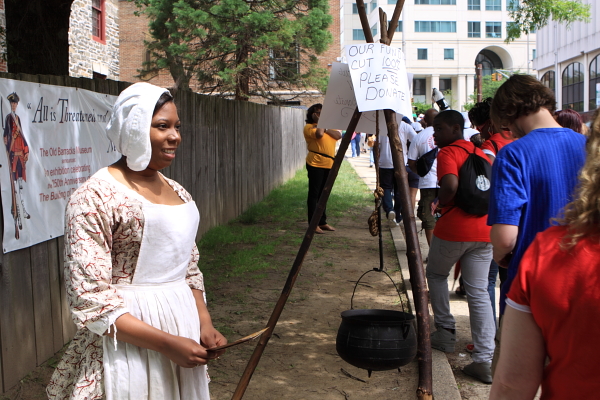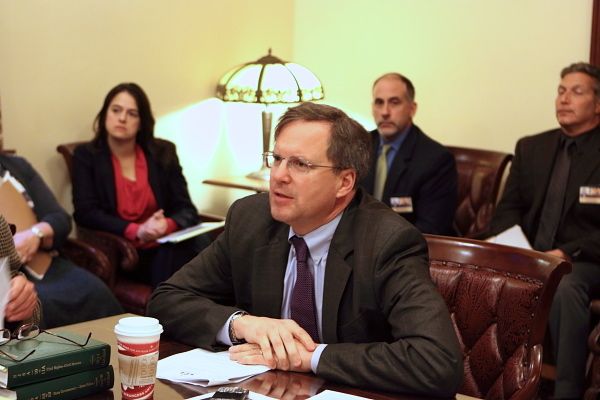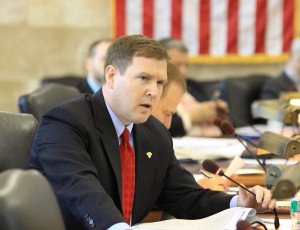Christie Buries Trenton’s History – Kills 1730’s Petty’s Run Restoration
[Update 2 : 1/27/11 – efforts are being made to stop DEP from burying the site, see today’s Trenton Times coverage: Historical society calls city dig site ‘endangered]
Update 1: 12/1/10 – NJ Newsroom coverage: Commission votes to fill in Petty’s Run archeological site on Statehouse grounds]
Trenton Times story: Plan to bury Trenton archaeological site is blasted – end updates]
In an appalling and senseless move to destroy a unique and valuable historical asset, an obscure body called the State Capitol Joint Management Commission voted this morning to kill the Petty’s Run Project.
The 5-2 vote allegedly was based on a recommendation by DEP Commissioner Bob Martin.
But, amazingly, on May 25, 2010, the same DEP Commissioner Bob Martin issued an historic preservation award to the Petty’s Run project, honoring it as an example of “NJ’s best and brightest”:
Petty’s Run Site archaeological explorations public outreach, Trenton, Mercer County
The Petty’s Run archaeological explorations were undertaken as part of the design of the proposed Capital State Park. Phase 1B of the park, just east of the State House, calls for a series of conserved foundations, restoration of flow to Petty’s Run, and the installation of an operational waterwheel in a 19th century paper-mill wheel pit to educate visitors about water-powered industry around the time of the American Revolution. The park design team realized the work, because of its location, would generate considerable attention. The team used the excavation itself to inform the public about the history of the site. Outreach included a web journal, an on-site interpreter, and periodic site tours and presentations.
The political decision to reverse course and kill the project was not based on any well considered rational plan, alternatives or as a cost savings move. Funding is available and dedicated by the voters, and the costs to close the project exceed those to finish it.
Similar to Christie’s termination of the tunnel to NYC known as “ARC”, “The state has money for the project that under law cannot be used elsewhere.”
The Capitol Joint Management Commission is Chaired by Governor Christie’s Chief Of Staff, Rich Bagger. News sources indicated that Lt. Governor Guadagno wanted the project killed because she didn’t like the view of it out her State House office window. (see Tom Hester, NJ Newsroom: Lt. Gov. Guadagno wants archeological dig on Statehouse lawn buried
So, while there was virtually zero public awareness or debate on costs or alternatives, the involvement of Bagger and Guadagno and the reversal of DEP’s prior support mean that the decision to kill the project was a political one made by Governor Christie.
Christie’ decision is an affront to NJ’s history and an attack on Trenton and the idea of urban parks in NJ. If defies strong public support for parks for people.
Petty’s Run is an ongoing archaelogical excavation and restoration of a mill that dates to pre-Revolutionary War Trenton of the 1730’s.
History buffs should visit Pettysrun.org for a description of the archaeological dig and restoration project, with excellent photos.
The Petty’s Run project is an essential element of Trenton’s Capital State Park (click here for Master Plan), which showcases Trenton’s rich history:
Capital State Park
The State of New Jersey is creating a new urban park in downtown Trenton. Named the Capital State Park and following a master plan created by WRT Design, the initial phase of the park focuses on the area between the State House and the War Memorial and on the strip of land extending up behind the Old Barracks Museum and Thomas Edison State College to West State Street. Ultimately Capital State Park seeks to reconnect the city to the Delaware River and the water resources that have underpinned its growth and prosperity.
Trenton’s rich history is one of the main themes that will be incorporated into the park design. The area behind the Barracks contains the buried remains of several 18th- and 19th-century industrial sites along Petty’s Run. The goal of the archaeological excavations currently in progress is to inform the park design and devise a means of exposing, stabilizing and displaying the buried ruins as an addition to the complex of historic sites that is anchored by the State House and the Old Barracks.
Read the Park Master Plan’s vision and design options for Petty’s Run (click here @ page 76)
NJ has just one urban State park, Liberty State Park in Jersey City. The new Capital State park would enrich the State park system, capitalize on Trenton’s tremendous historic assets, and serve as a magnet for tourist and historic preservation based economic development.
Funding for the Park was dedicated via the 2003 voter approved constitutional amendment to dedicate $50 million of corporate business tax proceeds to State Park maintenance and restoration. So budget shortfalls can not be the reason for killling this project.
This is politics at its worst – our sources told me that this battle is not over.
We’ll keep you posted. Below are photo’s I shot after the hearing this morning. They give a sense of the linkage to the Old Barracks and the State House.
[Update – photo reply to comment. Read the sign at Historic Barracks: “Our funds cut 100%, Please donate”. Shot at May 22, 2010 protest

Trenton's Historic Barracks fundraising at May 22, 2010 protest

